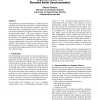Free Online Productivity Tools
i2Speak
i2Symbol
i2OCR
iTex2Img
iWeb2Print
iWeb2Shot
i2Type
iPdf2Split
iPdf2Merge
i2Bopomofo
i2Arabic
i2Style
i2Image
i2PDF
iLatex2Rtf
Sci2ools
SIGCSE
2000
ACM
2000
ACM
Experimentation with bounded buffer synchronization
Undergraduates are usually introduced to synchronization in operating systems through a discussion of classical problems such as reader-writer or producers-consumers. The traditional approach to teaching these topics is not effective in conveying to students how programs with incorrect synchronization actually behave. This paper introduces a simple probabilistic model for synchronization failure and shows how students can empirically study these issues. These activities are supported by a simulator that students can use to explore synchronization in the context of the bounded buffer problem. The simulator is written in Java and can be used either standalone or from a standard browser. Students can save the data and graphs generated by the simulator in a log file in HTML format.
| Added | 01 Aug 2010 |
| Updated | 01 Aug 2010 |
| Type | Conference |
| Year | 2000 |
| Where | SIGCSE |
| Authors | Steven Robbins |
Comments (0)

